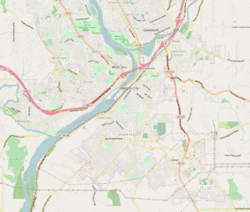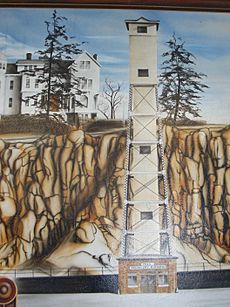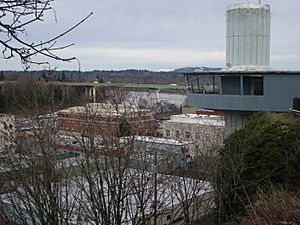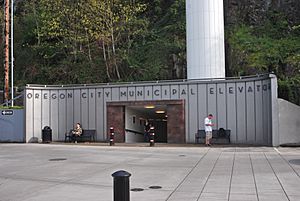Oregon City Municipal Elevator facts for kids
Quick facts for kids |
|
|
Oregon City Municipal Elevator
|
|
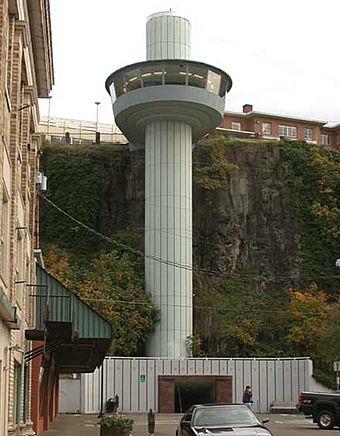 |
|
| Location | 610 Bluff Street Oregon City, Oregon |
|---|---|
| Built | 1955 |
| Built by | Otis Elevator Company |
| Architect | Gordon E. Trapp |
| NRHP reference No. | 14000181 |
| Added to NRHP | May 15, 2014 |
The Oregon City Municipal Elevator is a special elevator in Oregon City, Oregon. It connects two different parts of the city. This elevator is 130 feet (about 40 meters) tall.
It is one of only a few outdoor public elevators in the world. The top part of the elevator looks a bit like a flying saucer. It even has a viewing deck!
There have been two elevators in this spot. The one you see today was built in 1954–1955. It became a National Register of Historic Places site in 2014. This means it's an important historical landmark.
Contents
Oregon City's Unique Landscape
Oregon City has some very steep hills. The main downtown area is squeezed between the Willamette River and a tall rock cliff. This cliff is about 90 feet (27 meters) high.
Another neighborhood sits right on top of this cliff. For a long time, people needed a way to get between these two areas. Native American people first used trails to climb the cliff. Later, many stairways were built in the 1860s. But people still needed an easier way to travel up and down.
The First Elevator: A Big Step Up
The first elevator was built to help people move around the city. Before it, people had to climb 722 steps to get from the bottom to the top of the cliff!
In 1912, the city asked people to vote on spending $12,000 to build a public elevator. The first vote failed, but a second vote passed later that year.
A woman named Sara Chase owned the land where the elevator was planned. She didn't want to give up her property. The city had to go to court to get permission to build. Finally, she agreed to let them use a small part of her land.
The first elevator opened in 1915. It was powered by water and took three minutes to go up. It was made of wood and steel. If it ever stopped, passengers had to use a trap door and a ladder to get out. A walkway at the top connected the elevator to the cliff.
This elevator was very popular. Most of the old cliff stairs were removed. In 1924, it was changed to run on electricity. This made the ride much faster, only 30 seconds! After many years, in the 1950s, the city decided it was time for a new, modern elevator.
The Current Elevator: A Modern Ride
After 40 years, the first elevator was replaced. In 1952, people voted to spend $175,000 for a new one. The new design was meant to be simple and plain.
The current elevator was designed by Gordon E. Trapp. It was built by the Otis Elevator Company. It has push-button controls and automatic doors. The ride now takes only about 15 seconds. It opened on May 5, 1955, and is still working today! In 2004, its control system was updated with computers.
This elevator is so important that it's like a vertical part of 7th Street. Both its top and bottom entrances are on 7th Street. It's even called Elevator Street, which is the only vertical street in North America.
The bottom entrance is near 7th Street and Railroad Avenue. A short tunnel takes you under the train tracks to the elevator. The top entrance is from High Street. From the observation deck at the top, you can see Willamette Falls and two bridges: the Oregon City Bridge and the Abernethy Bridge.
The elevator used to have an operator. But since 2020, it has been self-service. It's open most days, and it's free to use! In 1989, about 500 people used it daily. By 2008, that number grew to nearly 800. During the summer, when tourists visit, up to 1,300 people ride it each day.
A project called "Illuminate Oregon City" once turned the elevator into a giant video screen. It showed videos and pictures of local sights. This special light show ran until 2015.
See also


